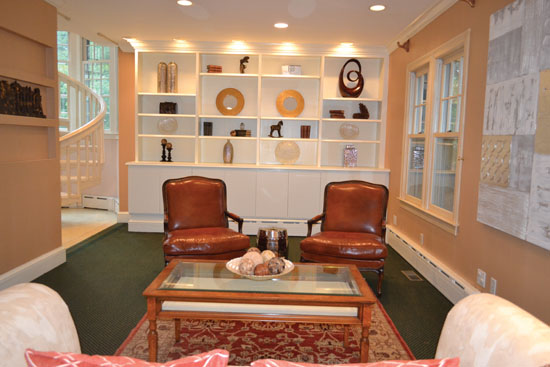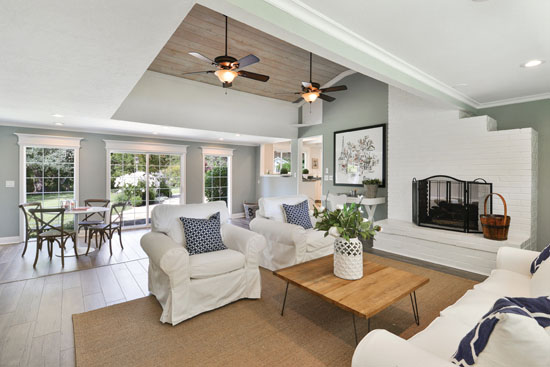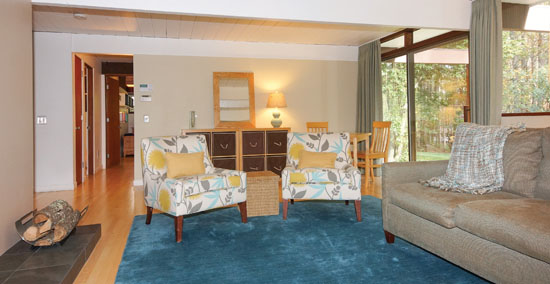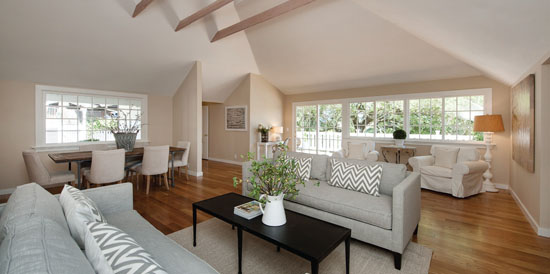|
|
Published July 27th, 2016
|
Setting the Stage for a Home Sale
|
|
| By Cathy Dausman |
 |
| Before staging. Photo courtesy Sarah Kellar, Dana Green Team |
You need a bigger home; you want a smaller home; you need to live in a different location. For whatever reason, you've decided to sell your home. You've hired a real estate agent and signed a contract. The stage is set for foot traffic; now let the offers start rolling in. Or will they? Do you think your home looks marketable? Should you elect to have your home-sweet-home professionally staged, and what advantages will that bring?
 Home staging has ceased to be an add-on real estate strategy and has become the norm, says realtor Dana Green of Lafayette's Dana Green Team. Where remodeling focuses on what Green calls the cosmetics of a property, she says staging breathes life into a property, represents each room with its proper scale, and declutters and neutralizes a home. Professional stagers, Green says, focus on preparing homes for sale to appeal to the broadest market of buyers while maintaining a fresh and updated inventory of accessories.
Home staging has ceased to be an add-on real estate strategy and has become the norm, says realtor Dana Green of Lafayette's Dana Green Team. Where remodeling focuses on what Green calls the cosmetics of a property, she says staging breathes life into a property, represents each room with its proper scale, and declutters and neutralizes a home. Professional stagers, Green says, focus on preparing homes for sale to appeal to the broadest market of buyers while maintaining a fresh and updated inventory of accessories.
 "I always hire a professional stager to come into the property and do a consult once we have signed a listing agreement," says Hollie Howell of Fusion Real Estate Network in Walnut Creek. Howell is a full time Realtor who has earned Accredited Staging Professional credentials. She is confident enough in the value added of home staging to split the cost with the seller as a credit against her commission. "I have yet to have a case where (staging) has not paid off," she said.
"I always hire a professional stager to come into the property and do a consult once we have signed a listing agreement," says Hollie Howell of Fusion Real Estate Network in Walnut Creek. Howell is a full time Realtor who has earned Accredited Staging Professional credentials. She is confident enough in the value added of home staging to split the cost with the seller as a credit against her commission. "I have yet to have a case where (staging) has not paid off," she said.
 Not all Realtors are stagers, says Jennie Norris, president and CEO of Stagedhomes.com, but they all need to know how to educate their sellers about the process. Norris, a past resident of Danville, Walnut Creek and San Ramon, says staging really took off in the San Francisco area 15 to 20 years ago. Before Norris listed her own home she says, "I had never heard of the term or process" but when her Realtor brought in a stager "our house looked great, (and) we got sold." Ironically, Norris moved to an area where she said staging was considered unnecessary. Stagers will tell you the unstaged homes are the ones that boost the sales price of homes that have been staged.
Not all Realtors are stagers, says Jennie Norris, president and CEO of Stagedhomes.com, but they all need to know how to educate their sellers about the process. Norris, a past resident of Danville, Walnut Creek and San Ramon, says staging really took off in the San Francisco area 15 to 20 years ago. Before Norris listed her own home she says, "I had never heard of the term or process" but when her Realtor brought in a stager "our house looked great, (and) we got sold." Ironically, Norris moved to an area where she said staging was considered unnecessary. Stagers will tell you the unstaged homes are the ones that boost the sales price of homes that have been staged.
 Barbara Schwarz, founder of the International Association of Home Staging Professionals, likens transforming your home into something potential buyers see as their home to theater design. The project includes a director or professional stager, producers (the seller and listing agent), and an audience composed of potential buyers. There even may be critics (other agents) eager to point out the listing shortfalls.
Barbara Schwarz, founder of the International Association of Home Staging Professionals, likens transforming your home into something potential buyers see as their home to theater design. The project includes a director or professional stager, producers (the seller and listing agent), and an audience composed of potential buyers. There even may be critics (other agents) eager to point out the listing shortfalls.
 Schwarz says home staging works in a variety of locales with homes either vacant or occupied, with new construction and resale residences.
Schwarz says home staging works in a variety of locales with homes either vacant or occupied, with new construction and resale residences.
 Schwarz emphasizes the "three C's" of home staging - cleaning at a top-to-bottom, white-glove level, decluttering, and assessing the color of walls and furnishings. Too much color may overwhelm potential buyers, too little will brand the spaces dull and drab. Schwarz suggests the stager and homeowner strive for neutral background colors then add punch in small doses with pillows, curtains or area rugs. A neutral gray wall color is currently in vogue.
Schwarz emphasizes the "three C's" of home staging - cleaning at a top-to-bottom, white-glove level, decluttering, and assessing the color of walls and furnishings. Too much color may overwhelm potential buyers, too little will brand the spaces dull and drab. Schwarz suggests the stager and homeowner strive for neutral background colors then add punch in small doses with pillows, curtains or area rugs. A neutral gray wall color is currently in vogue.
 Green says there are five steps sellers should take during the staging process. They should remove personal items, including family photos and children's art, remove items of value, clear floors of clutter, organize closets and repaint and clean or replace carpets.
Green says there are five steps sellers should take during the staging process. They should remove personal items, including family photos and children's art, remove items of value, clear floors of clutter, organize closets and repaint and clean or replace carpets.
 Nothing beats flowers when it comes to freshness, and both Green and Howell say they include a combination of quality artificial and real flowers in their staged homes. Howell cautions that real flowers must be changed out weekly, a chore she usually leaves to the professional stager.
Nothing beats flowers when it comes to freshness, and both Green and Howell say they include a combination of quality artificial and real flowers in their staged homes. Howell cautions that real flowers must be changed out weekly, a chore she usually leaves to the professional stager.
 Howell suggests adding a complete landscape "haircut" and fresh paint to the to-do list if timing allows; she'd also recommend a complete flooring update before a house goes on the market.
Howell suggests adding a complete landscape "haircut" and fresh paint to the to-do list if timing allows; she'd also recommend a complete flooring update before a house goes on the market.
 "If a client wants an 'as is' sale, they will take less of a price hit if at least those elements are covered," she said. Kitchens and bathrooms sell houses, Howell continues. When staging and remodeling are combined, the result "can often make more than a $100,000 or greater difference in the net (price)," she says. It may also trigger over-list-price offers.
"If a client wants an 'as is' sale, they will take less of a price hit if at least those elements are covered," she said. Kitchens and bathrooms sell houses, Howell continues. When staging and remodeling are combined, the result "can often make more than a $100,000 or greater difference in the net (price)," she says. It may also trigger over-list-price offers.
 A 2015 Profile of Home Staging by the National Association of Realtors says the median dollar cost to stage a home is $675. It lists the most common rooms to be staged in order of importance as living room, kitchen, master bedroom, dining room, bathroom, children's bedroom and guest bedroom. A house can be staged either using the homeowner's furniture or with items brought in from a stager's inventory of furnishings.
A 2015 Profile of Home Staging by the National Association of Realtors says the median dollar cost to stage a home is $675. It lists the most common rooms to be staged in order of importance as living room, kitchen, master bedroom, dining room, bathroom, children's bedroom and guest bedroom. A house can be staged either using the homeowner's furniture or with items brought in from a stager's inventory of furnishings.
 "We can do as little or as much as the client needs," Norris says.
"We can do as little or as much as the client needs," Norris says.
 For more information on staging, visit: http://blog.pacificunion.com/spring-staging-tips or http://www.iahsp.com.
For more information on staging, visit: http://blog.pacificunion.com/spring-staging-tips or http://www.iahsp.com.

|
 |
| After staging. Photo Jennie Norris, Stagedhomes.com |
 |
| Photo courtesy Sarah Kellar, Dana Green Team |
 |
| Photo courtesy Sarah Kellar, Dana Green Team |
 |
| Photo courtesy Sarah Kellar, Dana Green Team |
 |
| story-photo-caption6 |
|
|
|










